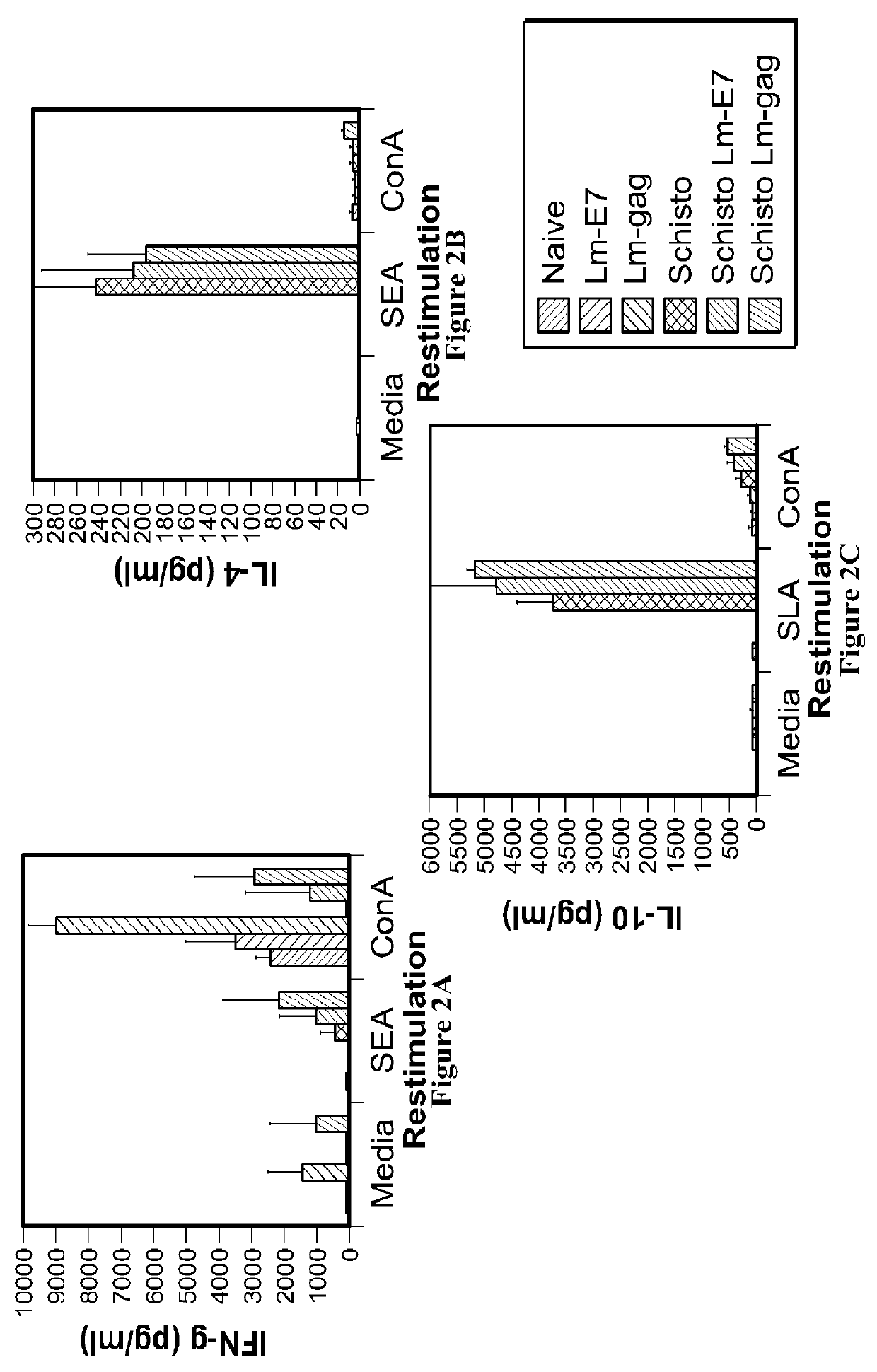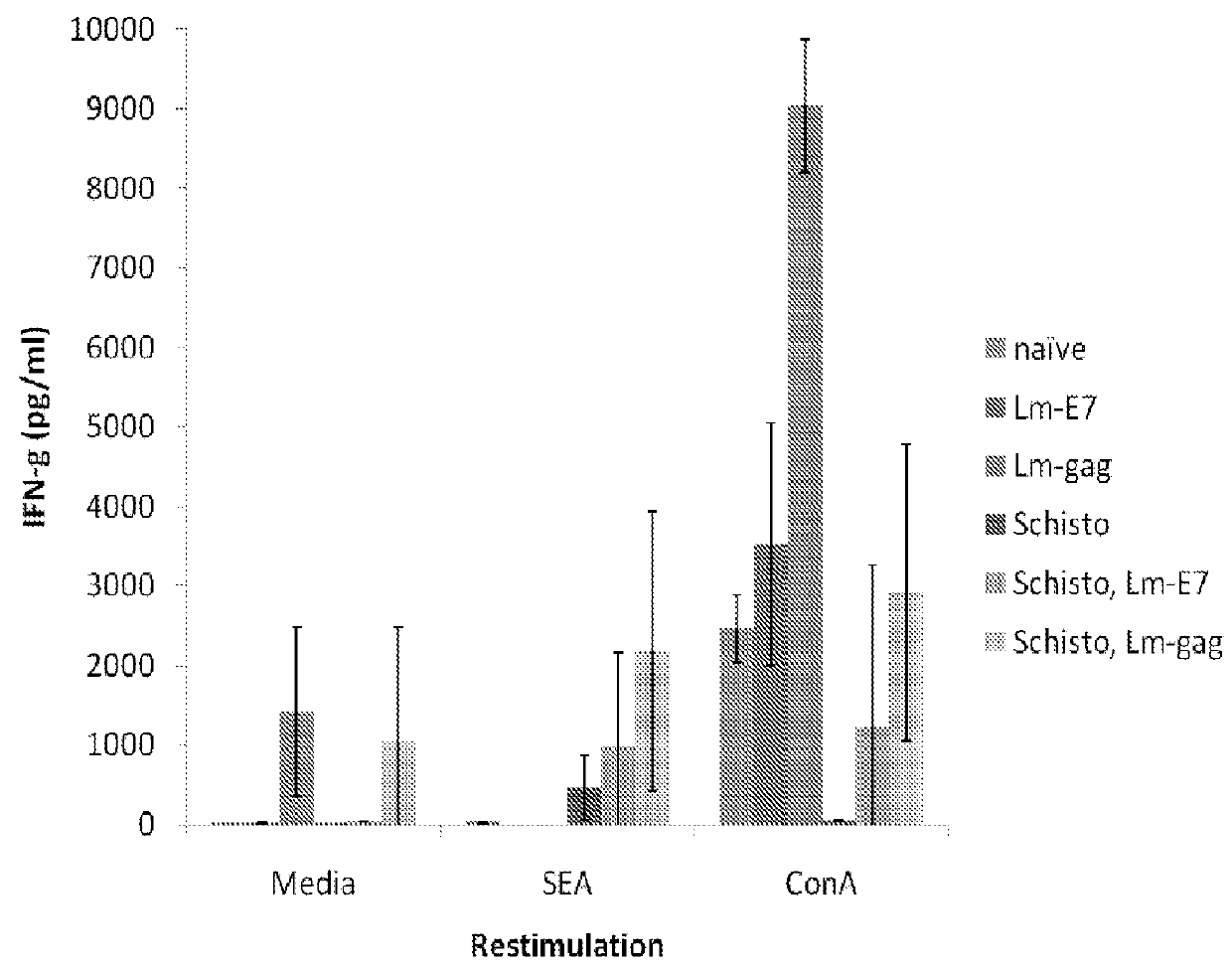Use of Listeria vaccine vectors to reverse vaccine unresponsiveness in parasitically infected individuals
a vaccine vector and listeria technology, applied in the field of use of i > listeria /i > vaccine vectors to reverse vaccine unresponsiveness in parasitically infected individuals, can solve the problems of helminth infected populations not generating the desired immune response, malaria or hiv-1 vaccines are not available, and tb and hiv-1 remain tremendous disease burdens in much of the world's population
- Summary
- Abstract
- Description
- Claims
- Application Information
AI Technical Summary
Benefits of technology
Problems solved by technology
Method used
Image
Examples
example 1
Vaccine Efficacy in a Model of Chronic Helminth Infection
[0218]A chronic Schistosoma mansoni infection is established in mice as a model of chronic helminth infection prior to vaccination with the Listeria-vector vaccines (FIG. 1). A hallmark of chronic helminth infection is Th2 biasing of the immune system, which is observed in the chronic schistosomiasis model used throughout this study (FIG. 2). Helminth-infected, Listeria HIV-1-vaccinated mice are Th2 biased and immune suppressed, as indicated by a reduction in IFN-γ production and increases in levels of IL-4 and IL-10 when comparing groups with and without helminth infection.
example 2
Listeria Vectors are Capable of Driving a Th1 T-Cell Immune Response Despite Helminth Infection-Mediated Suppression of Th1 T-Cell Immune Responses
[0219]Despite systemic biasing toward Th2, as evidenced by a reduced IFN-γ response (FIG. 3) and an increase in IL-4 and IL-10 production (FIGS. 4 and 5, respectively), antigen-specific production of IFN-γ remains unchanged (FIG. 6), indicating this vaccine can produce a functional cell-mediated immune response in the presence of a Th2 environment. This observation suggests that Listeria vector vaccines are capable of driving vaccine-specific immune responses in helminth-infected populations. Further, Listeria vectors should be considered in the development of new generation HIV-1, malaria or TB vaccines to be administered to populations in sub-Saharan Africa where helminth infection is highly prevalent.
example 3
Administration of a Listeria Vector-HIV-1 Gag Vaccine to S. Mansoni-Infected Mice Drives Significant Immune Responses to HIV-1 Gag CTL and T Helper Epitopes
[0220]Both a single i.p. vaccination with 0.2 LD50 of Lm-gag or a prime-boost vaccination protocol with 0.1 LD50 of Lm-gag elicits significant immune responses to HIV-1 gag CTL and T helper epitopes similar to the immune responses in non-S. mansoni-infected mice vaccinated with a prime-boost vaccination protocol with 0.1 LD50 of Lm-gag (FIG. 7).
[0221]In addition, oral administration of 100 LD50 but not 10 LD50 of Lm-gag in a prime-boost protocol elicited immune responses to gag-helper (but not gag-CTL) similar to the response elicited in i.p. Lm-gag-vaccinated mice and in oral Lm-gag-vaccinated mice that were not infected with S. mansoni (FIG. 8).
[0222]All groups demonstrated strong immune responses to conA (positive control) and no groups demonstrated immune response to medium or an irrelevant antigen (FIG. 8). In addition, mice...
PUM
| Property | Measurement | Unit |
|---|---|---|
| durable | aaaaa | aaaaa |
| time points | aaaaa | aaaaa |
| chemical | aaaaa | aaaaa |
Abstract
Description
Claims
Application Information
 Login to View More
Login to View More - R&D
- Intellectual Property
- Life Sciences
- Materials
- Tech Scout
- Unparalleled Data Quality
- Higher Quality Content
- 60% Fewer Hallucinations
Browse by: Latest US Patents, China's latest patents, Technical Efficacy Thesaurus, Application Domain, Technology Topic, Popular Technical Reports.
© 2025 PatSnap. All rights reserved.Legal|Privacy policy|Modern Slavery Act Transparency Statement|Sitemap|About US| Contact US: help@patsnap.com



